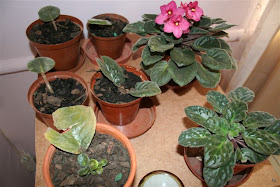 Above and below: my own potplant nursery
Above and below: my own potplant nursery
 I am rewarded with African Violets flowering for months
I am rewarded with African Violets flowering for months2. Over 20 wild species and variants have been found to date.
3. All wild species have blossoms in the blue-violet range, but other characteristics vary.
4. African Violets first made their way to North America via Europe in 1926.
5. The highly varied modern varieties are the result of hybridization.
The African Violet really is an African plant. As far as we knew it grew uncelebrated by botanists and plant-lovers for countless millennia. It had to wait until 1892 to be officially discovered by the Baron Walter von Saint Paul, the German governor of a north-eastern province in Tanganyika, now part of Tanzania. Von Saint Paul found the plant growing among shaded rocky ledges in the Usambara Mountains. He immediately sent seeds of his "Usambara violet" to his father in Germany. In Germany the plant acquired a botanical name which it still bears today: Saintpaulia. Other species closely related to this first were soon discovered. They all bear the genus name Saintpaulia plus an adjective describing the individual species. The original plant discovered by Walter von Saint Paul is Saintpaulia ionantha. There are more than twenty other similar but certainly not identical species in the genus. They have memorable names betraying what those naming them thought of them such as: Saintpaulia difficilis, S. confusa, S. inconspicua. Others have adjectival names indicating place of origin: S. magungensis, S. teitensis, S. tongwensis. Magunga, Teita, and Tongwe are all place names associated with Tanzania.
(Note: if you’d like to learn more about the beautiful Usambara Mountains and Tanzania, click here )
Here are a few tips gleaned from the article as well as a some of my own (the planting – part!) which I share with you:
Firstly, never wet an African Violets leaves. Water the saucer in which the pot plant is standing. An African violet likes to drink up the water through its roots. It also enjoys being root bound (huh?!?) and should be left undisturbed in its original pot for as long as possible. When the flowers begin to fade and die, remove them with your fingers by gently tugging them from the plant. An African Violet also likes to stand in a sunny position but not in direct sunlight. I have found that filtered sunlight is perfect for this plant.
When a leaf breaks off accidently, (which does happen) place it in a small glass of water over which you’ve spanned tin foil and pierced a hole into. Keep the water topped up, replacing completely once a week. Within a few weeks, the stalk begins to grow roots. When these are strong, you can plant the leave in potting soil. Soon you will be rewarded with “babies” (See photograph) When the mother leaf withers and dies, remove it gently and nurture the baby plants until they are fully fledged African Violet plants in their own right.
Happy potting!
What interesting info about the African Violet, Jo - I never knew that you should not wet their leaves, for example. Thanks for the great tips :)
ReplyDeleteHi Lynda, yes, most houseplants die because of overwatering (on or below the plant!) Thanks for popping in. Hugs Jo
ReplyDelete